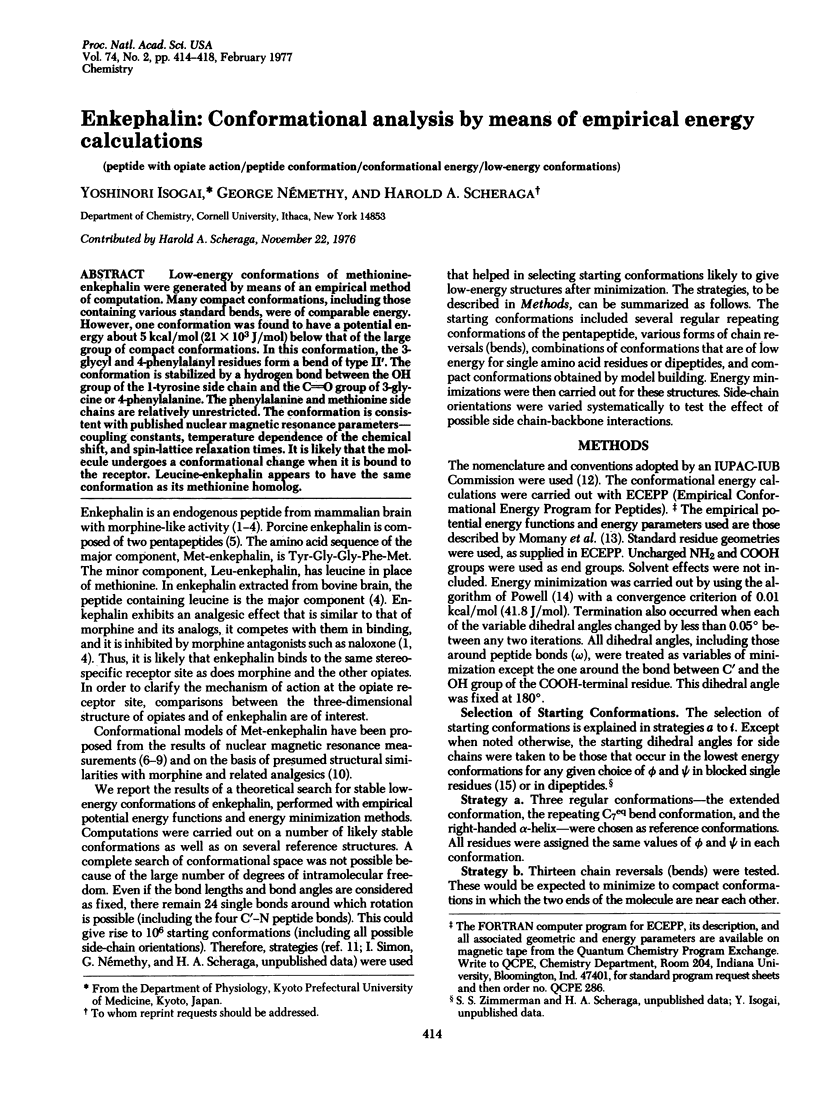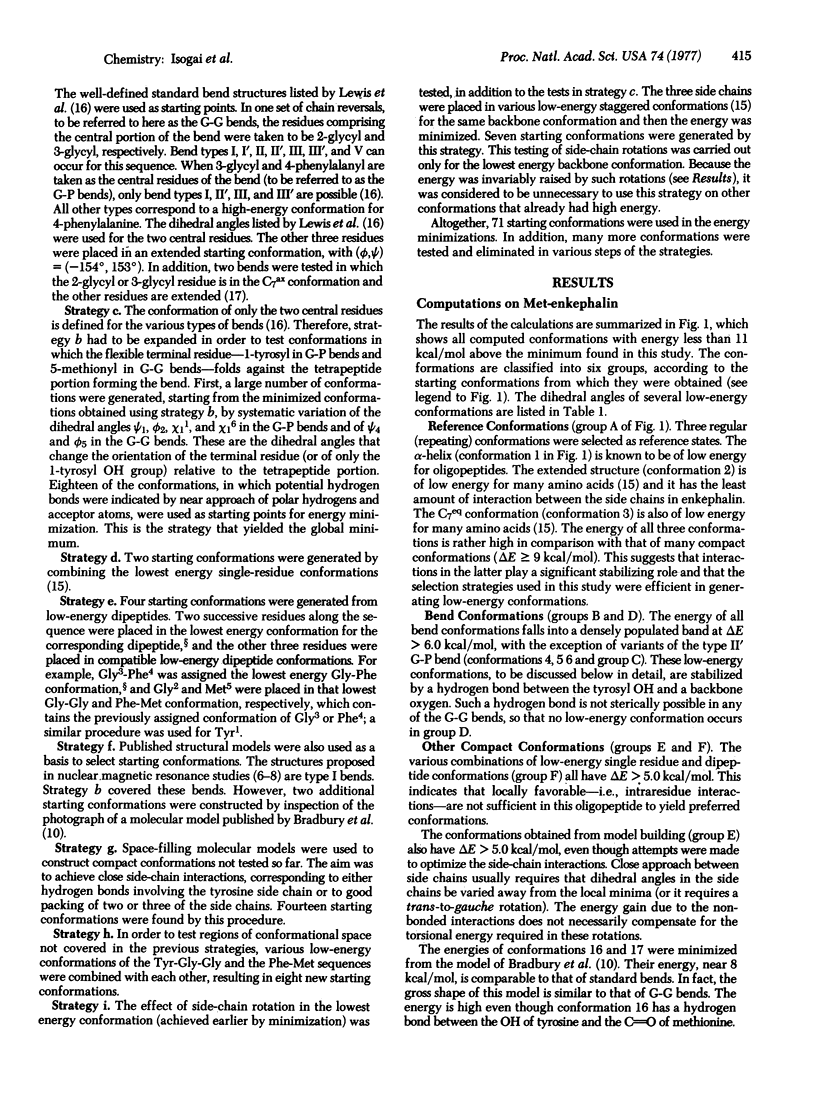Abstract
Low-energy conformations of methionine-enkephalin were generated by means of an empirical method of computation. Many compact conformations, including those containing various standard bends, were of comparable energy. However, one conformation was found to have a potential energy about 5 kcal/mol (21 X 10(3) J/mol) below that of the large group of compact conformations. In this conformation, the 3-glycyl and 4-phenylalanyl residues form a bend of type II'. The conformation is stabilized by a hydrogen bond between the OH group of the 1-tyrosine side chain and the C==O group of 3-glycine or 4-phenylalanine. The phenylalanine and methionine side chains are relatively unrestricted. The conformation is consistent with published nuclear magnetic resonance parameters--coupling constants, temperature dependence of the chemical shift, and spin-lattice relaxation times. It is likely that the molecule undergoes a conformational change when it is bound to the receptor. Leucine-enkephalin appears to have the same conformation as its methionine homolog.
Full text
PDF




Selected References
These references are in PubMed. This may not be the complete list of references from this article.
- Bleich H. E., Cutnell J. D., Day A. R., Freer R. J., Glasel J. A., McKelvy J. F. Preliminary analysis of 1H and 13C spectral and relaxation behavior in methionine-enkephalin. Proc Natl Acad Sci U S A. 1976 Aug;73(8):2589–2593. doi: 10.1073/pnas.73.8.2589. [DOI] [PMC free article] [PubMed] [Google Scholar]
- Bradbury A. F., Smyth D. G., Snell C. R. Biosynthetic origin and receptor conformation of methionine enkephalin. Nature. 1976 Mar 11;260(5547):165–166. doi: 10.1038/260165a0. [DOI] [PubMed] [Google Scholar]
- Buscher H. H., Hill R. C., Römer D., Cardinaux F., Closse A., Hauser D., Pless J. Evidence for analgesic activity of enkephalin in the mouse. Nature. 1976 Jun 3;261(5559):423–425. doi: 10.1038/261423a0. [DOI] [PubMed] [Google Scholar]
- Cung M. T., Marraud M., Neel J. Experimental calibration of a Karplus relationship in order to study the conformations of peptides by nuclear magnetic resonance. Macromolecules. 1974 Sep-Oct;7(5):606–613. doi: 10.1021/ma60041a012. [DOI] [PubMed] [Google Scholar]
- Garbay-Jaureguiberry C., Roques B. P., Oberlin R. Preferential conformation of the endogenous opiate-like pentapeptide Met-enkephalin in DMSO-D6 solution determined by high field H NMR. Biochem Biophys Res Commun. 1976 Jul 26;71(2):558–565. doi: 10.1016/0006-291x(76)90823-8. [DOI] [PubMed] [Google Scholar]
- Horn A. S., Rodgers J. R. Structural and conformational relationships between the enkephalins and the opiates. Nature. 1976 Apr 29;260(5554):795–797. doi: 10.1038/260795a0. [DOI] [PubMed] [Google Scholar]
- Howard J. C., Ali A., Scheraga H. A., Momany F. A. Investigation of the conformations of four tetrapeptides by nuclear magnetic resonance and circular dichroism spectroscopy, and conformational energy calculations. Macromolecules. 1975 Sep-Oct;8(5):607–622. doi: 10.1021/ma60047a008. [DOI] [PubMed] [Google Scholar]
- Hughes J., Smith T. W., Kosterlitz H. W., Fothergill L. A., Morgan B. A., Morris H. R. Identification of two related pentapeptides from the brain with potent opiate agonist activity. Nature. 1975 Dec 18;258(5536):577–580. doi: 10.1038/258577a0. [DOI] [PubMed] [Google Scholar]
- Hughes J., Smith T., Morgan B., Fothergill L. Purification and properties of enkephalin - the possible endogenous ligand for the morphine receptor. Life Sci. 1975 Jun 15;16(12):1753–1758. doi: 10.1016/0024-3205(75)90268-4. [DOI] [PubMed] [Google Scholar]
- Jones C. R., Gibbons W. A., Garsky V. Proton magnetic resonance studies of conformation and flexibility of enkephalin peptides. Nature. 1976 Aug 26;262(5571):779–782. doi: 10.1038/262779a0. [DOI] [PubMed] [Google Scholar]
- Lewis P. N., Momany F. A., Scheraga H. A. Chain reversals in proteins. Biochim Biophys Acta. 1973 Apr 20;303(2):211–229. doi: 10.1016/0005-2795(73)90350-4. [DOI] [PubMed] [Google Scholar]
- Pasternak G. W., Goodman R., Snyder S. H. An endogenous morphine-like factor in mammalian brain. Life Sci. 1975 Jun 15;16(12):1765–1769. doi: 10.1016/0024-3205(75)90270-2. [DOI] [PubMed] [Google Scholar]
- Pert C. B., Pert A., Chang J. K., Fong B. T. (D-Ala2)-Met-enkephalinamide: a potent, long-lasting synthetic pentapeptide analgesic. Science. 1976 Oct 15;194(4262):330–332. doi: 10.1126/science.968485. [DOI] [PubMed] [Google Scholar]
- Roques B. P., Garbay-Jaureguiberry C., Oberlin R., Anteunis M., Lala A. K. Conformation of Met5-enkephalin determined by high field PMR spectroscopy. Nature. 1976 Aug 26;262(5571):778–779. doi: 10.1038/262778a0. [DOI] [PubMed] [Google Scholar]
- Simantov R., Snyder H. Isolation and structure identification of a morphine-like peptide "enkephalin" in bovine brain. Life Sci. 1976 Apr 15;18(8):781–787. doi: 10.1016/0024-3205(76)90002-3. [DOI] [PubMed] [Google Scholar]
- Terenius L., Wahlström A., Lindeberg G., Karlsson S., Ragnarsson U. Opiate receptor affinity of peptides related to Leu-enkephalin. Biochem Biophys Res Commun. 1976 Jul 12;71(1):175–179. doi: 10.1016/0006-291x(76)90265-5. [DOI] [PubMed] [Google Scholar]


